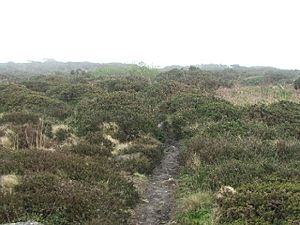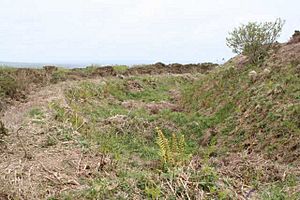Caer Bran facts for kids
Caer Bran Hill Fort is an ancient site in Cornwall, England. It's located near the villages of Sancreed and Carn Euny. This area is part of the Penwith peninsula. Caer Bran is a great example of an Iron Age hill fort. It shows us how people lived and defended themselves long ago.
Contents
Exploring Caer Bran Hill Fort
Caer Bran is a popular spot for people who love to walk and explore history. It offers amazing views of the entire Penwith peninsula. This wide view was probably very important for defense in ancient times.
What You Can See at the Site
The site was once a strong hill fort. It had a large circular inner wall made of stone. This wall was about twelve feet thick. It enclosed a space about 200 feet wide. Around this wall was a deep ditch. This ditch was forty-five feet wide and seven feet deep. Beyond the ditch was an earthen rampart, which was like a fifteen-foot-high earth wall. This rampart also had stone on its sides.
There was a special path over the ditch at the entrance. This entrance was on the northwest side. It was close to an old track that connected Penzance to Land's End. In the very center of the fort, you can still see the remains of a large circular stone building. It was about fifty feet across.
Older Discoveries
Inside the outer ramparts, archaeologists found three Bronze Age ring cairns. These are ancient stone circles, often used for burials. Most of the original stone from the fort was taken away in the 1800s. People used it to build other things.
Why Was it Built?
The fort was likely built to protect valuable metals. People in this area mined tin, copper, and silver. These metals were then taken to nearby ports. From there, they would be shipped out from places like Mount's Bay or the Hayle estuary. Caer Bran overlooked at least three other Iron Age villages nearby. This shows its importance for the whole community.
Stories and Legends of Caer Bran
The name "Caer Bran" has a special meaning. "Caer" is a Cornish word that means "fortress." "Bran" means "Raven" or "Crow." The name might be linked to a nearby village called Brane. This name comes from "Bosvran," meaning "the house of Bran."
Bran the Blessed
Some people think this "Bran" might be Bran the Blessed. He is a giant and a king from old Welsh stories called the Mabinogion. He is also similar to the Fisher King from Arthurian legends. The Fisher King was the keeper of the Holy Grail. Bran the Blessed was said to live in a castle called Corbenic. This name sounds a lot like "Corben," an old French word for Crow.
The Mên Scryfa Stone
In Cornish folklore, the name Bran is also connected to the Mên Scryfa. This is a tall granite pillar with an old inscription. It says "rialobrani cunovali fili," which means "royal raven glorious prince." A legend tells of an invader who attacked this glorious prince. The invader took over a hill fort in Penzance. This forced Bran back to his fort at Caer Bran. A big battle was fought, and Bran was killed. He might have been on his way to Chûn Castle. A stone was put up where he died. It was said to be as tall as the warrior himself.
Little People and Fairies
Local legends say that Caer Bran was a safe place from bad spirits. It was also believed to be the home of the Pobel Vean. This is Cornish for "Little people," or fairies.
Nearby Places to Explore
- Carn Euny Iron Age Village and fogou: This ancient village is about half a mile to the west. A fogou is a mysterious underground passage.
- Bartinney Castle: This is another Iron Age enclosure. It's about 1 mile to the west.
- Sancreed Beacon: This is a hill to the northeast, about half a mile away.
Images for kids




